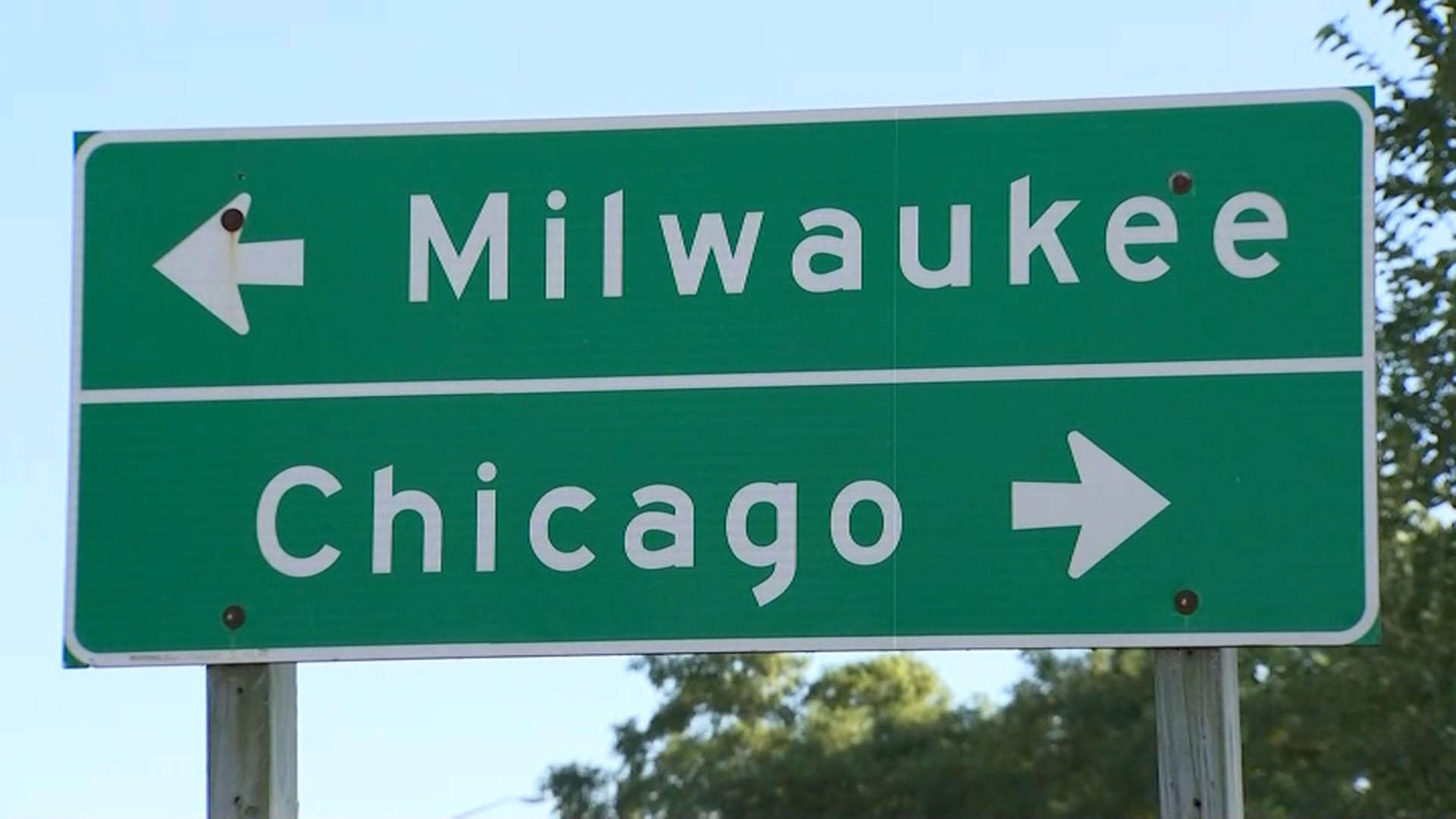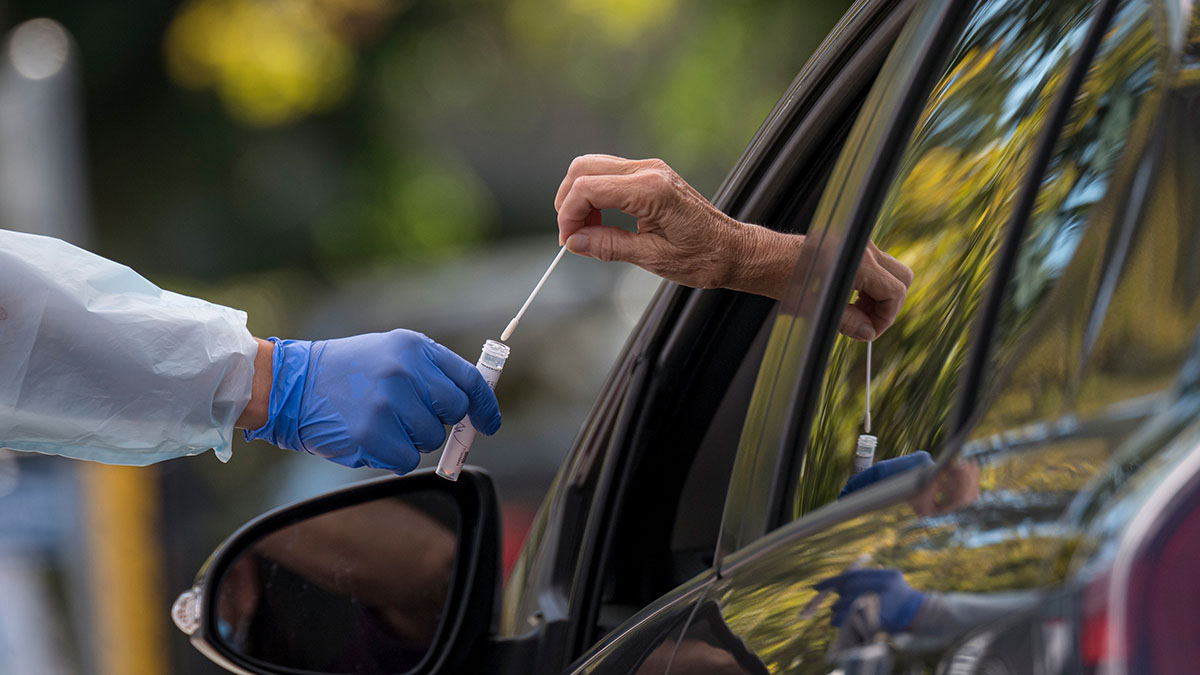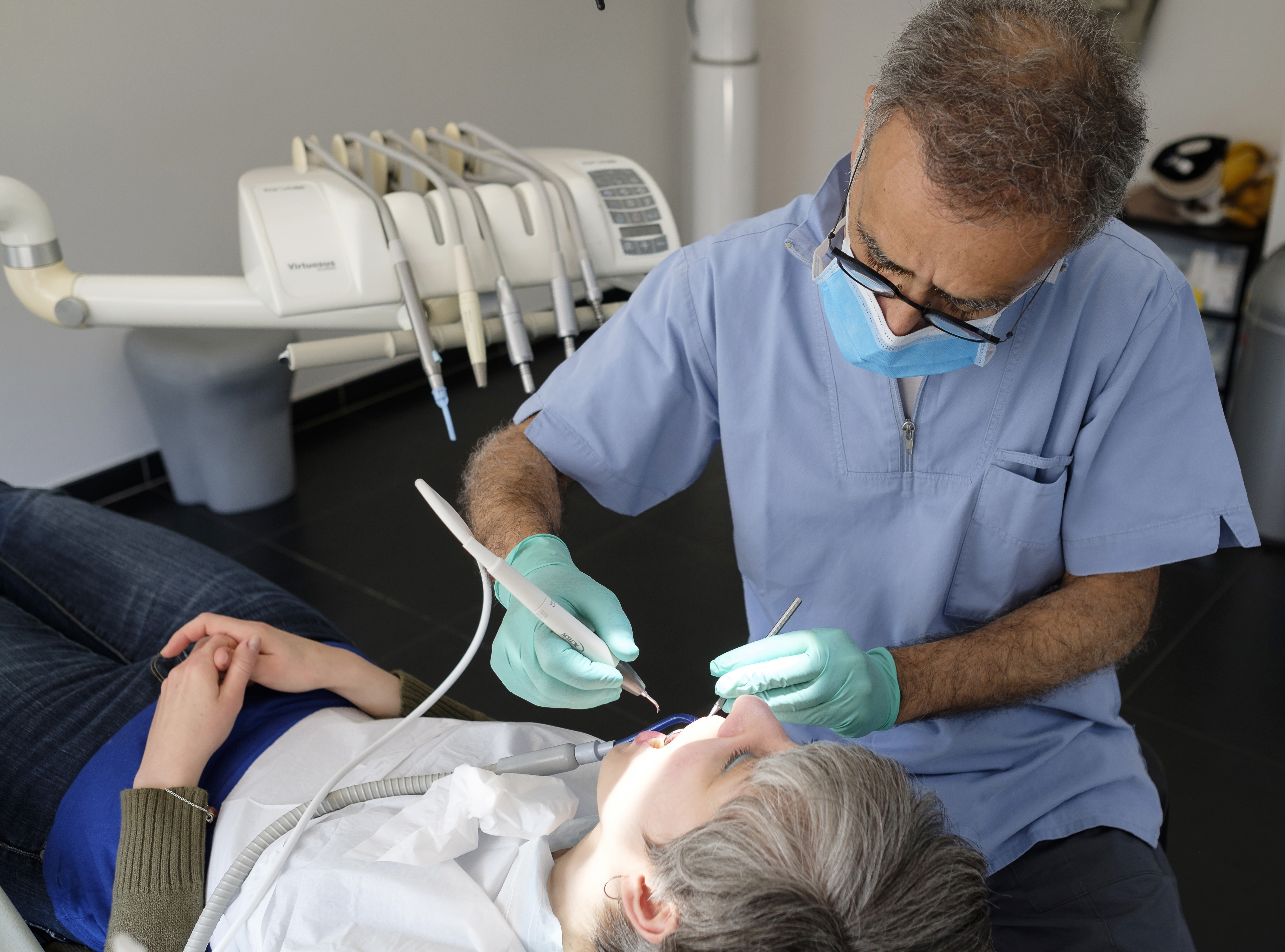Note: Press conferences from Gov. J.B. Pritzker or Chicago Mayor Lori Lightfoot will be streamed live in the video player above.
The governor is expected to extend Illinois' moratorium on evictions before it expires on Saturday, his office says.
That comes as the state set a single-day record for coronavirus testing two days in a row.
Here are the latest coronavirus headlines from around the state today, Aug. 20:
20 Illinois Counties Now at 'Warning Level' for Coronavirus, Health Dept. Says
Twenty counties in Illinois are now at a "warning level" for coronavirus, the state's health department said Friday.
The warning means each of the counties saw increases in two or more COVID-19 "risk indicators," the health department said.
The counties now under a warning include: Bureau, Cass, Clay, Clinton, Franklin, Greene, Grundy, Hancock, Henderson, Jefferson, Logan, Madison, Monroe, Moultrie, Randolph, St. Clair, Union, White, Will, and Williamson.
Last week, 14 counties were at a "warning level," 11 of which remained on the list Friday.
The counties each "saw outbreaks associated with weddings, businesses, neighborhood gatherings, parties, long-term care facilities and other congregate settings, travel to neighboring states, bars, sports camps, and spread among members of the same household who are not isolating at home," IDPH said in a release. Some cases were also connected to schools, health officials said,
"Public health officials are observing people not social distancing or using face coverings," IDPH's release read. "Additionally, there are reports of individuals who are ill attributing their symptoms to allergies or other illnesses, or not being forthcoming about their symptoms or close contacts."
Illinois Reports 2,208 New Coronavirus Cases as State Sets Testing Record for 3rd Day
Health officials in Illinois confirmed 2,208 new cases of coronavirus on Friday as the state reported a single-day testing record for the third day in a row.
According to new data from the Illinois Department of Health, the total number of coronavirus cases during the pandemic so far now sits at 215,929.
Friday's 24 additional deaths bring the state’s death toll from the virus to 7,857 total fatalities.
According to officials, a total of 51,736 new tests were performed over the last 24 hours, marking yet another daily record and topping Thursday's 51,612. That brings the statewide total to 3,592,919.
Friday's results also drop the state’s 7-day rolling positivity rate to 4.3%, according to newly available data.
Hospitalization numbers increased slightly Friday, with 1,526 coronavirus patients currently hospitalized in the state. Of those patients, 351 are currently housed in intensive care units, while 121 patients are currently on ventilators, marking a slight decrease for both numbers.
Pritzker Expected to Extend Eviction Moratorium
Gov. J.B. Pritzker plans to extend Illinois’ moratorium on evictions before it expires at the end of the week, his office said Thursday.
“The Governor will extend the moratorium when the current executive orders expire,” Pritzker spokeswoman Jordan Abudayyeh said in an email.
The moratorium’s executive order is tied to the state’s disaster proclamation, which has to be renewed monthly, Abudayyeh said. The current eviction moratorium expires Saturday.
Sheriff Tom Dart Wednesday urged Pritzker in a public letter to renew the moratorium until state and local agencies had finished issuing financial aid to homeowners and tenants. Dart warned that letting the moratorium expire would put as many as 250,000 households in the county at risk of eviction during the coronavirus pandemic.
After the letter was published, a group of Chicago landlords pleaded for more help for building owners.
“Many families are suffering a COVID-related loss of income but so are many of the people who provide them with their homes,” the Neighborhood Building Owners Alliance said in a statement. “In this COVID era, the cost of providing housing has increased while rental income has declined due to the inability of many tenants to pay their rent.”
Neighborhood Building Owners Alliance President Michael Glasser added, “Chicago’s housing market is fragile right now, and housing providers need support. In order for tenants to be secure, housing needs to be stable and we need the federal government to increase relief for struggling renters and housing providers working to keep people in their homes.”
The City of Chicago has allocated $33 million in rental assistance to 10,000 homes, while Cook County is providing $20 million to 4,400 suburban households. The state is offering $5,000 rental assistance grants, part of $150 million in funds Illinois received from the CARES Act.
Illinois Reports 1,832 New Coronavirus Cases as State Sets Another Daily Testing Record
Health officials in Illinois confirmed 1,832 new cases of coronavirus on Thursday as the state reported a daily testing record for the second day in a row.
According to new data from the Illinois Department of Health, the total number of coronavirus cases during the pandemic so far now sits at 213,721.
Thursday's 27 additional deaths bring the state’s death toll from the virus to 7,833 total fatalities.
According to officials, a total of 51,612 new tests were performed over the last 24 hours, marking yet another daily record and bringing the statewide total to 3,541,183.
Thursday's new test results also keep the state’s 7-day rolling positivity rate at 4.4%, according to newly available data.
Hospitalization numbers were held steady Thursday, with 1,519 coronavirus patients currently hospitalized in the state. Of those patients, 357 are currently housed in intensive care units, while 124 patients are currently on ventilators.
Illinois' 7-Day Coronavirus Case Count Hits 3 Times What It Was at Pandemic's Low Point
The number of new coronavirus cases reported in Illinois over the past week has reached three times what it was at the pandemic's low point across the state in late June, according to public health data released Wednesday.
Health officials in Illinois reported 2,295 new coronavirus cases on Wednesday, as the rolling positivity rate continued to gradually increase and the state set a new record for single-day testing, performing more than 50,000 tests in 24 hours for the first time since the pandemic began.
That nearly 2,300 new cases brought the statewide total to 211,889 confirmed cases, health officials said.
It also brought the total number of cases reported in the past seven days to 13,296, data shows. That same figure, the seven-day total number of cases, hasn't been above 13,000 since late May.
The seven-day total peaked at 17,957 cases reported in the week leading up to May 4, data shows, and continued to hover around that mark through mid-May before beginning to fall. Illinois reported 13,148 new cases in the week leading up to May 28, similar to the numbers reported as of Wednesday - only in May, the state was trending downwards.
Numbers continued to fall through June, with the seven-day total reaching just 4,186 new cases reported in the week leading up to June 23. That marked the lowest point in reported cases before Illinois' numbers began to climb once again.
Cases have climbed - which can be attributed in part to increases in testing capacity as well as spread of the virus - to the point where Wednesday's seven-day total of 13,296 cases is more than three times that low point reported on June 23.
While Illinois is testing more people than ever, the high number of cases reported Wednesday can't be explained solely by that, as the state also reported another increase in its positivity rate. The rate ticked up to 4.4% on Wednesday, health officials say, increasing by one-tenth of a point each day for the past four days in a row.
Saliva-Based Coronavirus Test Developed by U of I Puts Illinois on ‘Cutting Edge,' Officials Say
For the first time, Illinois health officials are beginning to utilize a new saliva-based coronavirus test developed at the University of Illinois’ Urbana-Champaign campus, and as a result the state was able to conduct more than 50,000 new COVID-19 tests over the last 24 hours.
“This development by the University of Illinois is truly going to have the effect of helping us (with) fast testing, fast results, isolating people faster and contact tracing,” Gov. J.B. Pritzker said. “All of those things have an enormously positive effect.”
According to Illinois Department of Public Health Director Dr. Ngozi Ezike, the saliva tests, recently given a green light by the Food and Drug Administration under the administration’s emergency use authorization powers, were included in Wednesday’s testing totals for the first time, allowing the state to set a new record for coronavirus tests within a 24-hour period.
“Today’s news puts the University of Illinois and the entire state of Illinois on the cutting edge of testing innovation on a national level,” Ezike said. “And let me just say to (University of Illinois) President Dr. Tim Killeen, the state of Illinois looks forward to being your biggest customer.”
According to Ezike and other health officials, the saliva-based tests are a major breakthrough in coronavirus testing for multiple reasons, including their cheaper costs, faster results and relative ease of accessing the materials needed to conduct and screen the tests.
“Even among the very few saliva tests available globally, it’s one of the least expensive and potentially most effective now on the market,” Ezike said.
According to Dr. Killeen, the test is very inexpensive compared to other testing kits, with a cost of just $10 per kit. Those students who take the test can have test results sent directly to their phones with their test results, which will likely be available within just 24 hours instead of the several days that nose swab tests take to process.
The swab test is already being used at the university, with more than 10,000 faculty and staff members taking tests on Monday alone. That number, according to Killeen, accounted for 1.3% of the testing in the entire United States on Monday.
State officials are working to deploy the tests to more public universities across the state in coming weeks and months, and will work to make the testing available for students in K-12 schools and for residents of long-term care facilities as well.
According to Pritzker and other state officials, the tests will require several weeks to roll out to other entities, but the production process should be much faster than other more material-intensive tests, thereby helping to expedite that process.
Other schools and businesses have also begun to achieve good results with saliva-based tests, with one such test funded by the National Basketball Association gaining FDA emergency approval earlier this week. Yale University also has developed a saliva-test for COVID-19.
Flu Season Could Have Even Bigger Impact in Age of Coronavirus, Doctors Warn
The coronavirus already poses a serious threat to healthcare systems in the United States, but with the fall approaching, doctors and health officials are warning that a bad flu season could cause even greater challenges.
Dr. Sharon Welbel of the Cook County Health System says the effects on the healthcare system could be devastating if this year’s flu season is as bad as ones in years past.
“We know that millions of people every year in the United States get influenza,” Welbel said. “Thousands of people, probably over 60,000 people last year, died of the flu.”
Now, with coronavirus cases on the rise in Illinois and many neighboring states, Welbel says the risk of some patients contracting both viruses is a very real and serious threat.
“People can get the flu and COVID at the same time, and one can imagine how incredibly ill one can become having both diseases at the same time,” Welbel said. “The other issues are diagnostic difficulties, testing difficulties, access to vaccines and so forth.”
Doctors have warned that patients exhibiting symptoms of the flu will likely have to be tested for coronavirus as well, as the two viruses do share some common symptoms.
One of the best ways to protect yourself against the flu, or to potentially ease the impact the virus can have on you, is to get a flu vaccine, and doctors are sounding the alarm this year that a flu vaccine could be more critical than ever.
“Everyone is eligible to get their flu vaccine, and you should get it every single year,” Welbel said.
Besides the flu vaccine, Welbel says there are other encouraging signs for physicians hopeful to avoid a double-whammy of surges in COVID-19 and flu cases. In Australia, where flu cases are known to generally spike before spiking in the United States, the flu season has been light so far, giving some hope that this season’s strain of the virus may not be as intense.
Scientists and doctors are also hopeful that the spread of the flu won’t be as prevalent this year due to the protective steps that individuals are already taking to avoid coronavirus, including wearing masks, social distancing, and staying home when feeling ill.
“I’m hoping that this is true, but we as individuals have to be responsible,” Welbel said. “We as individuals can make that happen by wearing our masks, social distancing and getting our flu vaccines. When COVID-19 vaccines are available, we should get vaccinated for that as well.”
Pritzker Says State Closely Monitoring 2 Regions for 'Troubling Trends'
Illinois Gov. J.B. Pritzker said Wednesday that most of Illinois' 11 regions are seeing increases in positivity rates, but two in particular are reporting "troubling trends" as the state continues to see a rise in coronavirus metrics.
Already, the state's Region 4, the Metro East region, is under stricter mitigation requirements implemented by the state after the area rose above an 8 percent positivity rate for three days in a row. As of Tuesday, the region had a positivity rate of 9.4 percent and Pritzker warned additional restrictions like the full closure of indoor dining and drinking could soon be put in place.
In addition to Region 4, Pritzker said Regions 2, 3, 4, 8, 9, 10 and 11 have also seen an increase in their seven-day rolling average positivity rate. Only three regions - Regions 1, 5 and 6 - have seen slight decreases.
"Across the state, our 11 Restore Illinois regions are trending in different directions, the majority of which are negative," Pritzker said.
Of those seeing increases in positivity rates, Pritzker said officials are "closely monitoring" what he called "troubling trends" in Region 7, which includes Kankakee and Will counties, as well as Region 5 in southern Illinois.
"I want to emphasize again that local elected officials and health officials should pay close attention to the data for their communities and, where necessary, step up and impose greater mitigations on a targeted basis to bring down the number of infections and the positivity rate," Pritzker said. "Otherwise, it may only be a matter of time before the state will be forced to step in on a regional basis in other areas and impose resurgence mitigations like closing bars, indoor dining, limiting all indoor gatherings to even smaller capacity and more to reduce the spread of the virus."
Watch: Dr. Arwady Breaks Down Chicago's Latest COVID-19 Data
See How Illinois' Coronavirus Regions and Counties Compare in Key Metrics
How do each of Illinois' 11 regions and several counties across the Chicago area compare when it comes to key coronavirus metrics?
Dive into the most important data with this searchable tool that shows some of the numbers health experts examine when making decisions about potential restrictions and other efforts to slow the pandemic's spread.
Updated every evening, this chart shows the number of cases each county or region has reported in the last seven days and its total number of cases since the pandemic began.
The chart also shows each area's current positivity rate in testing, as well as two important figures adjusted for population: the total number of cases per 100,000 people, as well as the rolling average daily new case count per 100,000 people over the previous seven days.




